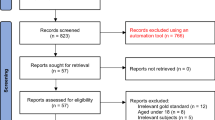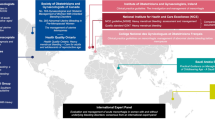Abstract
This review provides a status on the definition, prevalence, causes, and consequences of anemia in women who have given childbirth, i.e., postpartum anemia. The diagnosis of iron deficiency anemia relies on a full blood count including hemoglobin, serum ferritin, and serum soluble transferrin receptor, which appear to be reliable indicators of anemia and iron status 1 week postpartum while serum transferrin saturation is an unreliable indicator several weeks after delivery. It is recommended that postpartum anemia should be defined by hemoglobin <110 g/L at 1 week postpartum and <120 g/L at 8 weeks postpartum. The major causes of postpartum anemia are prepartum anemia combined with acute bleeding anemia due blood losses at delivery. Normal peripartum blood losses are approximately 300 ml, but hemorrhage >500 ml occur in 5–6% of the women. In healthy women after normal delivery, the prevalence of anemia (hemoglobin <110 g/L) 1 week postpartum is 14% in iron-supplemented women and 24% in non-supplemented women. In consecutive series of European women, the prevalence of anemia 48 h after delivery is approximately 50%. In developing countries, the prevalence of postpartum anemia is in the range of 50–80%. Postpartum anemia is associated with an impaired quality of life, reduced cognitive abilities, emotional instability, and depression and constitutes a significant health problem in women of reproductive age.


Similar content being viewed by others
References
Milman N (2008) Prepartum anaemia: prevention and treatment. Ann Hematol 87:949–959
Protonotariou E, Chrelias C, Kassanos D, Kapsambeli H, Trakakis E, Sarandakou A (2010) Immune response parameters during labor and early neonatal life. In Vivo 24:117–123
Bodnar LM, Siega-Riz AM, Miller WC, Cogswell ME, McDonald T (2002) Who should be screened for postpartum anemia? An evaluation of current recommendations. Am J Epidemiol 156:903–912
Bergmann RL, Richter R, Bergmann KE, Dudenhausen JW (2010) Prevalence and risk factors for early postpartum anemia. Eur J Obstet Gynecol Reprod Biol 150:126–131
Åkesson A, Bjellerup P, Berglund M, Bremme K, Vahter M (1998) Serum transferrin receptor: a specific marker of iron deficiency in pregnancy. Am J Clin Nutr 68:1241–1246
Åkesson A, Bjellerup P, Berglund M, Bremme K, Vahter M (2002) Soluble transferrin receptor: longitudinal assessment from pregnancy to postlactation. Obstet Gynecol 99:260–266
Milman N, Byg K-E, Bergholt T, Eriksen L, Hvas A-M (2006) Body iron and individual iron prophylaxis in pregnancy—should the iron dose be adjusted according to serum ferritin? Ann Hematol 85:567–573
Goetzl L, Manevich Y, Roedner C, Praktish A, Hebbar L, Townsend DM (2010) Maternal and fetal oxidative stress and intrapartum term fever. Am J Obstet Gynecol 202(363):e1–e5
Larsson A, Palm M, Hansson L-O, Basu S, Axelsson O (2008) Reference values for α1-acid glycoprotein, α1-antitrypsin, albumin, haptoglobin, C-reactive protein, IgA, IgG and IgM during pregnancy. Acta Obstet Gynecol Scand 87:1084–1088
Breymann C, Richter C, Hüttner C, Huch R, Huch A (2000) Effectiveness of recombinant erythropoietin and iron sucrose vs. iron therapy only, in patients with postpartum anemia and blunted erythropoiesis. Eur J Clin Invest 30:154–161
Wågström E, Åkesson A, Van Rooijen M, Larson B, Bremme K (2007) Erythropietin and intravenous iron therapy in postpartum anemia. Acta Obstet Gynecol Scand 86:957–962
Hendrick V, Altshuler LL, Suri R (1998) Hormonal changes in the postpartum and implications for postpartum depression. Psychosomatics 39:93–101
Lee W, Pivarnik J (1992) Hemodynamic studies during pregnancy. J Matern Fetal Med 1:75–77
Varga I, Rigó J Jr, Somos P, Joó JG, Nagy B (2000) Analysis of maternal circulation and renal function in physiologic pregnancies; parallel examinations of the changes in the cardiac output and the glomerular filtration rate. J Matern Fetal Med 9:97–104
Milman N, Agger OA, Nielsen OJ (1991) Iron supplementation during pregnancy. Effect on iron status markers, serum erythropoietin and human placental lactogen. A placebo controlled study in 207 Danish women. Dan Med Bull 38:471–476
Koller O (1982) The clinical significance of hemodilution during pregnancy. Obstet Gynecol Surv 37:649–652
World Health Organization (2001) Iron deficiency anemia. Assessment, prevention, and control. WHO/NHD/01.3
Bodnar LM, Cogswell ME, Scanlon KS (2002) Low income postpartum women are at risk of iron deficiency. J Nutr 132:2298–2302
Milman N, Byg K-E, Graudal N, Agger AO (2000) Reference values for hemoglobin and erythrocyte indices during normal pregnancy in 206 women with and without iron supplementation. Acta Obstet Gynecol Scand 78:89–98
Milman N, Bergholdt T, Byg K-E, Eriksen L, Hvas A-M (2007) Reference intervals for haematological variables during normal pregnancy and postpartum in 433 healthy Danish women. Eur J Haematol 79:39–46
Milman N, Ibsen KK, Christensen JM (1987) Serum ferritin and iron status in mothers and newborn infants. Acta Obstet Gynecol Scand 66:205–211
Somdatta P, Reddaiah VP, Singh B (2009) Prevalence of anemia in the postpartum period: a study of a North Indian village. Trop Doct 39:211–215
Richter C, Huch A, Huch R (1995) Erythropoiesis in the postpartum period. J Perinat Med 23:51–59
Milman N, Bergholt T, Eriksen L, Byg K-E, Graudal N, Pedersen P, Hertz J (2005) Iron prophylaxis during pregnancy—how much iron is needed? A randomised, controlled study of 20 to 80 mg ferrous iron daily to pregnant women. Acta Obstet Gynecol Scand 84:238–247
Milman N (2011) Anemia—still a major health problem in many parts of the world! Ann Hematol 90:369–377
Milman N, Byg K-E, Hvas A-M, Bergholt T, Eriksen L (2006) Erythrocyte folate, plasma folate and plasma homocysteine during normal pregnancy and postpartum: a longitudinal study comprising 404 Danish women. Eur J Haematol 76:200–205
Milman N, Byg K-E, Bergholt T, Eriksen L, Hvas A-M (2006) Cobalamin status during normal pregnancy and postpartum. A longitudinal study comprising 406 Danish women. Eur J Haematol 76:521–525
Mørkbak AL, Hvas A-M, Milman N, Nexø E (2007) Holotranscobalamin remains unchanged during pregnancy. Longitudinal changes of cobalamins and their binding proteins during pregnancy and postpartum. Haematologica 92:1711–1712
Milman N, Byg K-E, Ovesen L (2000) Iron status in Danes updated 1994. II. Prevalence of iron deficiency and iron overload on 1319 women aged 40–70 years. Influence of blood donation, alcohol intake, and iron supplementation. Ann Hematol 79:612–621
Milman N, Clausen J, Byg K-E (1998) Iron status in 268 Danish women aged 18–30 years. Influence of menstruation, method of contraception, and iron supplementation. Ann Hematol 76:13–19
Nybo M, Friis-Hansen L, Felding P, Milman N (2007) Higher prevalence of anemia among pregnant immigrant women compared to pregnant ethnic Danish women. Ann Hematol 86:647–651
Waldmann A, Koschizke JW, Leitzmann C, Hahn A (2004) Dietary iron intake and iron status of German female vegans: results of the German vegan study. Ann Nutr Metab 48:103–108
Harvey LJ, Armah CN, Dainty JR, Foxall RJ, John Lewis D, Fairweather-Tait SJ (2005) Impact of menstrual blood loss and diet iron on iron deficiency among women in the UK. Br J Nutr 94:557–564
Milman N, Søndergaard M, Sørensen CM (1985) Iron stores in female blood donors evaluated by serum ferritin. Blut 51:337–345
Milman N, Kirchhoff M (1991) Influence of blood donation on iron stores assessed by serum ferritin and haemoglobin in a population survey of 1359 Danish women. Ann Hematol 62:27–32
Milman N, Kirchhoff M, Jørgensen T (1992) Iron status markers, ferritin and hemoglobin in 1359 Danish women in relation to menstruation, hormonal contraception, parity and postmenopausal hormone treatment. Ann Hematol 65:96–102
Milman N (2006) Iron prophylaxis in pregnancy—general or individual and in which dose? Ann Hematol 85:821–828
Makrides M, Crowther CA, Gibson RA, Gibson RS, Skeaff CM (2003) Efficacy and tolerability of low-dose iron supplements during pregnancy: a randomised controlled trial. Am J Clin Nutr 78:145–153
Royal College of Obstetricians and Gynaecologist, Green top guidelines, November 2009 http://www.rcog.org.uk/files/rcog-corp/Green-top52PostpartumHaemorrhage.pdf
Rajan PV, Wing DA (2010) Postpartum hemorrhage: evidence-based medical interventions for prevention and treatment. Clin Obstet Gynecol 53:165–181
Groot AN, van Roosmalen J, van Dongen PW, Borm GF (1996) A placebo-controlled trial of oral ergometrine to reduce postpartum hemorrhage. Acta Obstet Gynecol Scand 75:464–468
Gilbert L, Porter W, Brown VA (1987) Postpartum haemorrhage—a continuing problem. British Journal of Obstetrics and Gynaecology 94:67–671
Kavle JA, Khalfan SS, Stoltzfus RJ, Witter F, Tielsch JM, Caulfield LE (2006) Measurement of blood loss at childbirth and postpartum. Int J Gynecol Obstet 95:24–28
Roberts CL, Ford JB, Thomson JF, Morris JM (2008) Population rates of hemorrhage and transfusions among obstetric patients in NSW: a short communication. Aust N Z J Obstet Gynaecol 48:481–484
Al-Zirqi I, Vangen S, Forsen L, Stray-Pedersen B (2008) Prevalence and risk factors of severe obstetric hemorrhage. BJOG 115:1265–1272
Oyelese Y, Ananth CV (2010) Postpartum hemorrhage: epidemiology, risk factors, and causes. Clin Obstet Gynecol 53:147–156
Newton M (1966) Postpartum hemorrhage. Am J Obstet Gynecol 94:711–717
Danish Society for Obstetrics and Gynaecology http://www.dsog.dk
Rouse DJ, MacPherson C, Landon M, Varner MW, Leveno KJ, Moawad AH et al (2006) Blood transfusion and cesarean delivery. Obstet Gynecol 108:891–897
Bruner A, Joffe A, Duggan AK, Casella JF, Brandt J (1996) Randomised study of cognitive effects of iron supplementation in non-anemic iron-deficient adolescent girls. Lancet 348:992–996
Rowland TW, Deisroth MB, Green GM, Kelleher JF (1988) The effect of iron therapy on the exercise capacity of non-anemic iron-deficient adolescent runners. Am J Dis Childhood 142:165–169
Gibbs R (1980) Clinical risk factors for puerperal infection. Obstet Gynecol 55(Suppl 5):178S–184S
Vora M, Gruslin A (1998) Erythropoietin in obstetrics. Obstetrical and Gynecological Survey 53:500–508
Beard JL, Hendricks MK, Perez EM et al (2005) Maternal iron deficiency anemia affects postpartum emotions and cognition. J Nutr 135:267–272
Corwin EJ, Murray-Kolb LE, Beard JL (2003) Low hemoglobin level is a risk factor for postpartum depression. J Nutr 133:4139–4142
Beard JL, Hendricks MK, Perez EM, Murray-Kolb LE, Berg A, Vernon-Feagans L, Irlam J, Isaacs W, Sive A, Tomlinson M (2005) Maternal iron deficiency anemia affects postpartum emotions and cognition. J Nutr 135:267–272
Meyer JW, Eichhorn KH, Vetter K, Christen S, Schleusner E, Klos A, Huch A, Huch R (1995) Does recombinant human erythropoietin not only treat anemia but reduce postpartum (emotional) distress as well? J Perinat Med 23:99–109
Murray-Kolb LE, Beard JL (2009) Iron deficiency and child and maternal health. Am J Clin Nutr 89:946S–950S
World Health Organization. Reduction of maternal mortality. A joint WHO/UNFPA/UNICEF/World Bank statement. Geneva: World Health Organization, 1999
Potts M, Campbell M (2004) Three meetings and fewer funerals: misoprostol in postpartum hemorrhage. Lancet 364:1110–1111
Tsu VD, Shane B (2004) New and underutilized technologies to reduce maternal mortality: call to action from a Bellagio workshop. Int J Gynecol Obstet 85(Suppl 1):S83–S93
Recommendation to prevent and control iron deficiency in the United States. MMWR Morb Mortal Wkly Rep 1998; 47(RR-3):13–25
Author information
Authors and Affiliations
Corresponding author
Rights and permissions
About this article
Cite this article
Milman, N. Postpartum anemia I: definition, prevalence, causes, and consequences. Ann Hematol 90, 1247–1253 (2011). https://doi.org/10.1007/s00277-011-1279-z
Received:
Accepted:
Published:
Issue Date:
DOI: https://doi.org/10.1007/s00277-011-1279-z




